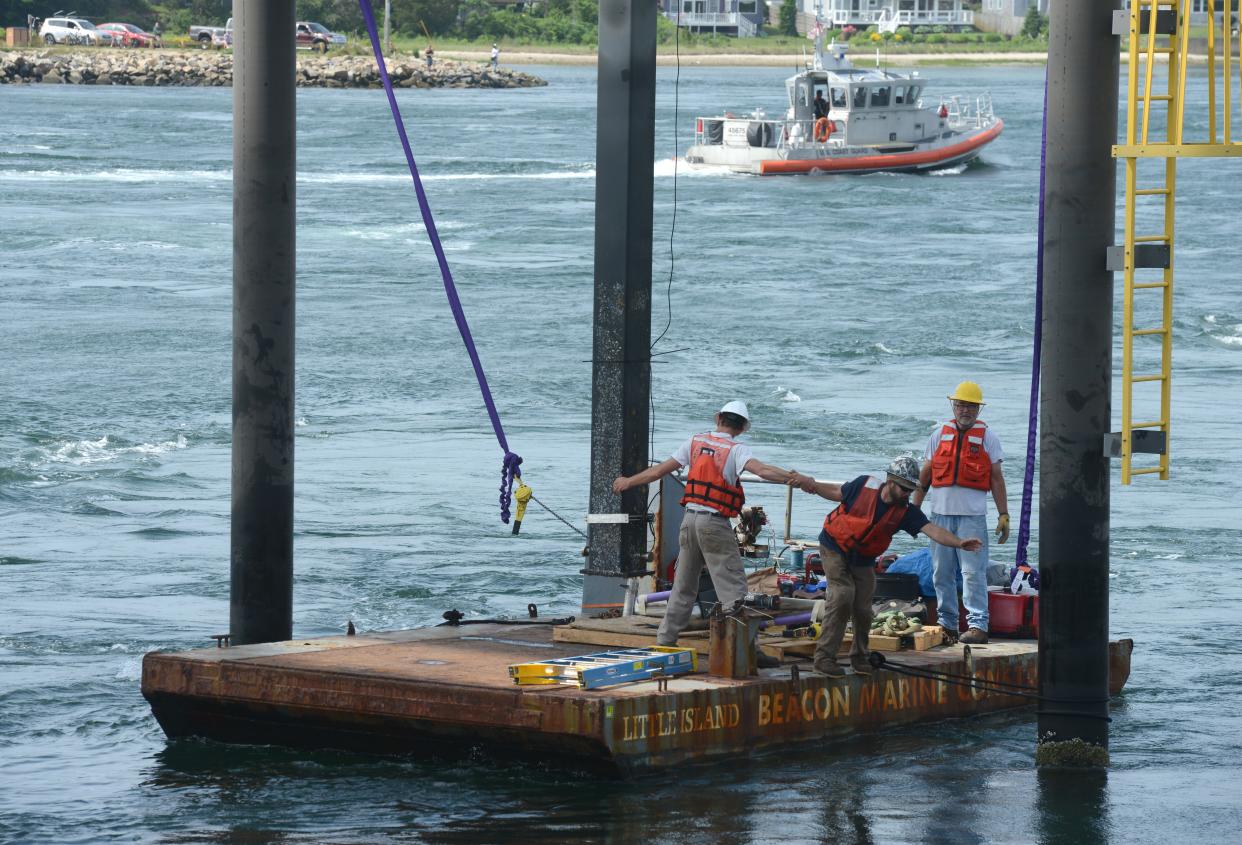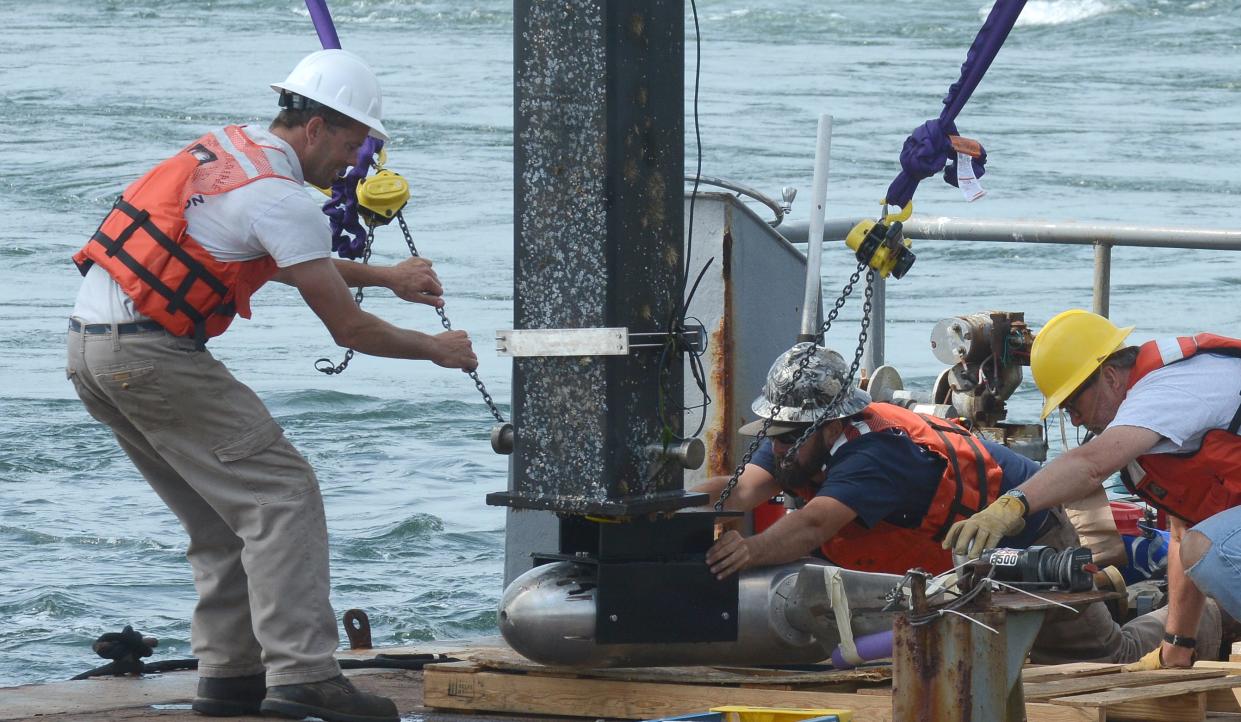Harnessing the tides. Cape Cod Canal site gets federal OK to test water-powered turbines
Cape Codders and Islanders know about harnessing ocean winds to create renewable energy.
The region has become a pioneer with the nation's first large-scale offshore wind farm — Vineyard Wind.
Now Cape Cod may be on the cusp of being a national trail blazer for another green technology, one that uses the power of the ocean itself — and, by extension, the moon — to make electricity.
Marine Renewable Energy Collaborative, a Marion nonprofit that promotes sustainable development of renewable energy in New England ocean waters, has secured an 8-year pilot license from the Federal Energy Regulatory Commission to test prototypes of turbines that harness tides to create energy.
How will Cape Cod Canal be used to pilot tidal energy?
The testing will be done in the Cape Cod Canal, at the Bourne Tidal Test Site just offshore on the west end of the waterway. Any energy that's produced will be transmitted into the New England power grid by way of nearby Eversource substations.
A comment from Eversource officials was not immediately available Friday.

"We're the only tidal test site to get a FERC license, which is not easy to get" said John Miller, executive director of the collaborative.
The federal agency, which oversees the nation's hydroelectrical, wave and tidal power resources, reviewed the proposal for two years before granting the license, he said.
Bourne site has been doing testing since 2017. What's different?
The Bourne test site was installed in 2017 and has been providing a platform for testing standalone, small-scale tidal turbine prototypes and other marine-related technologies under a permit from the U.S. Army Corps of Engineers. But any power produced by the tidal devices had to be dispersed through heaters. The prototypes could be up to 10 feet in diameter, compared to the full-size devices which are 30 to 40 feet wide.
"Just the concept of having to burn off the power, having heaters out there in the middle of summer, just doesn't make sense," Miller said. "This license allows the turbines to generate renewable electricity directly to the grid."
The prototype devices are not going to generate a tremendous amount of energy — about 30 kilowatts, he said. The testing will also provide as a good demonstration of the technology's usefulness, he said.
What needs to be done next?
Miller said the next step will be to run a power transmission line from the test platform to shore, which will then get strung overhead along the railroad tracks there. OpenCape Corporation, a nonprofit technology company headquartered in Barnstable, plans to replace old utility poles along the route. The collaborative will be able to use those for its power line, though that still requires approval from the state Department of Transportation.
"It's not a huge high-power line, but it still gets electricity to the grid," Miller said. "That's important, too, because people building these turbines want to make money, and having a test site like this lets them show they can put electrons into the grid."
Why is the federal license significant?
With the federal license in hand, Miller said the collaborative can provide tidal turbine developers the chance to test designs to an extent they could not before. Devices will be tested for efficiency, generation capacity, durability and any potential environmental effects.

According to the collaborative, developing budding tidal turbine technology is "very challenging and costly." University test tanks, the organization notes on its website, can only test small prototypes and components of less than three feet. Testing larger devices in the ocean requires extensive permitting that takes time and is costly, which has slowed the development of the technology.
"Even to do a demonstration you're supposed to go through FERC, so you spend hundreds of thousands, if not millions, to get a permit," Miller explained. "What we've done is build a site that's pre-permitted. What this is all about is making it quicker and cheaper for people who have new technologies to get them tested."
The collaborative was also just approved to participate in the U.S. Department of EnergyTEAMER, or Testing Expertise and Access for Marine Energy Research, program, through which "they will pay us directly to test companies' turbines," he said. There are presently three turbine developers who've indicated they want to test prototypes on the Bourne platform with TEAMER financial support.
Miller said tests take place over 30 days and cost about $200,000.
How do tidal turbines work?
The flow of the tides is what makes tidal turbines work. Taking advantage of the canal's fast-moving waters, the Bourne site is a fixed platform that allows the free flow of water around and under it — unlike barges and bulkheads that disrupt flows. The stand includes a lifting arm that gives easy access for tidal turbines while the stability allows better accuracy from sensors. According to the collaborative, it is "the only test site with these capabilities in the U.S. and perhaps the world."
Will a tidal power station be developed in the canal?
While the Cape Cod Canal will be key to development of tidal energy as a renewable resource in the future, a full-scale tidal power plant there is not part of the end game.
"The canal is too restrictive for that," Miller said.
But the Muskegat Channel between Martha's Vineyard and Nantucket could be a good candidate for tidal power production, he said.
There are presently no full-scale tidal power plants in the U.S. It has been estimated that tidal energy could provide a tenth of the world’s electricity needs and Massachusetts waters could generate the equivalent of a nuclear power plant, according to the collaborative. The organization further points out that tidal turbine energy "has been shown to have minimal impact on the environment."
Tidal power would augment other renewable resources
Although Miller noted that offshore wind, especially in New England, "has the potential for much greater power generation than tidal," it can't replace fossil fuel-powered energy resources alone.
“To meet climate change challenges, we need all the sources of renewable energy available," he said. "Tidal energy is an important piece of the mix because it is reliable, predictable, and available along coasts where population densities are highest."
Heather McCarron can be reached at hmccarron@capecodonline.com, or follow her on X @HMcCarron_CCT
Thanks to our subscribers, who help make this coverage possible. If you are not a subscriber, please consider supporting quality local journalism with a Cape Cod Times subscription. Here are our subscription plans.
This article originally appeared on Cape Cod Times: Energy through tides? Cape Cod Canal site gets federal OK to test
